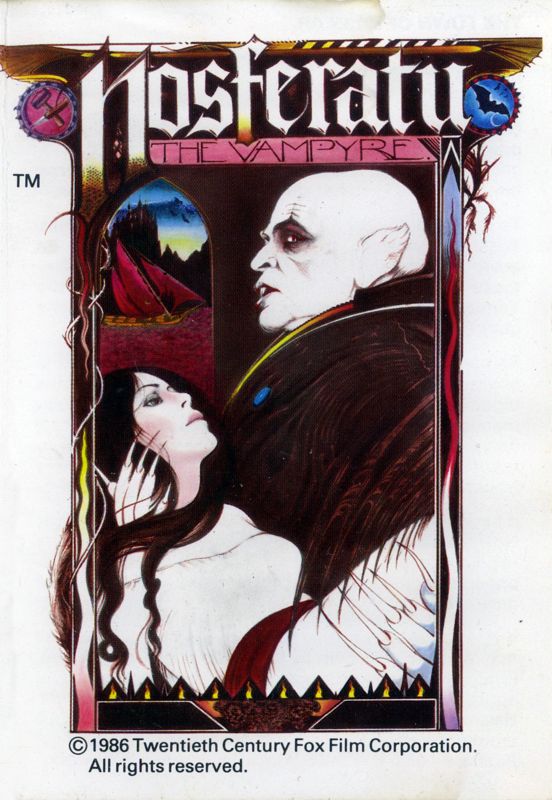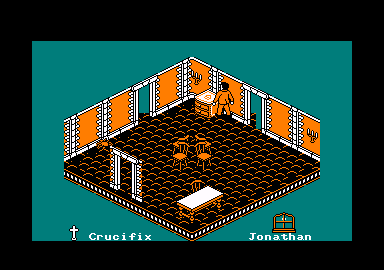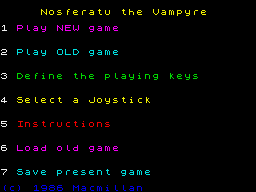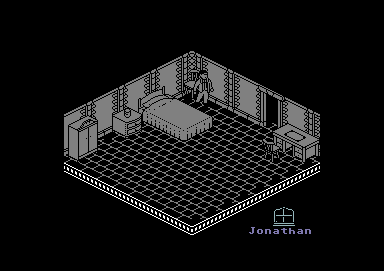Retro Replay Review
Gameplay
Nosferatu the Vampyre adopts an isometric perspective reminiscent of classic Filmation titles, offering a unique blend of exploration and puzzle-solving. Players navigate a series of interconnected rooms, manipulating objects with varying physics based on shape and centre of gravity. This level of interaction adds depth to simple tasks – pushing barrels, stacking crates, and balancing furniture all feel tactile and deliberate.
The game unfolds across three distinct stages. In the first, you guide Jonathan Harker through the eerie corridors of Castle Dracula to recover crucial documents for an estate agent’s office and ultimately find an escape route. Stage two expands the roster by introducing Lucy and Professor Van Helsing, allowing you to switch between characters to utilise their individual abilities—Harker’s agility, Lucy’s stealth, and Van Helsing’s knowledge of vampire lore.
Resource management is integral to survival. Characters must collect food to maintain their strength, and they can arm themselves with crucifixes and candles to fend off the undead. The balance between exploration, item collection, and enemy avoidance creates measured tension, demanding thoughtful planning rather than frantic button-mashing.
Graphics
True to its 8-bit roots, Nosferatu the Vampyre presents a monochrome palette even on machines capable of richer colour. This deliberate choice heightens the gothic atmosphere, lending every corridor and crypt a stark, haunting quality. Shadows stretch across walls, and silhouetted props convey enough detail to spark the imagination without overwhelming the limited hardware.
The isometric viewpoint delivers a satisfying sense of depth, especially when interacting with objects. Barrels roll convincingly, crates topple realistically, and candles can be lit or knocked over, all within the same visual framework. These subtle animations breathe life into static rooms, making each location feel both functional and foreboding.
Character sprites are small but expressive, with simple yet recognizable designs for Harker, Lucy, Van Helsing, and the vampire himself. The limited animation frames are cleverly used to signal important actions—like Lucy raising her crucifix or Van Helsing studying tomes—ensuring gameplay cues remain clear even amid dimly lit environments.
Story
Based on Werner Herzog’s 1979 film Nosferatu the Vampyre, the game faithfully adapts the movie’s gothic themes and character dynamics. Rather than merely retelling scenes, it expands upon them by placing players in the roles of different protagonists, each with a personal stake in the vampire’s downfall. This structure encourages multiple playstyles and perspectives on the same narrative framework.
The progression from Harker’s initial infiltration, through Lucy’s courageous pursuit, to her solitary confrontation with Nosferatu creates a compelling arc. Dialogue is sparse but atmospheric—text scrolls appear between stages to set the mood, and in-game clues hint at Dracula’s motivations. The minimalist storytelling suits the retro format, leaving room for player interpretation without sacrificing coherence.
Moments of tension arise organically through level design rather than cutscenes. Sneaking past undead guards or solving environmental puzzles to unlock forbidden chambers captures the spirit of the source material. While the plot doesn’t diverge significantly from the film, the interactive medium adds a sense of agency, making players feel directly responsible for each narrative turn.
Overall Experience
Nosferatu the Vampyre stands out as a retro-style adventure that leverages its film license to full effect. The isometric exploration, combined with varied object physics and strategic resource management, delivers an engrossing challenge. While the monochrome visuals may initially seem austere, they contribute to a suspenseful atmosphere that few colour-heavy titles of the era match.
The pacing is deliberate, rewarding careful observation and inventory juggling over fast-paced action. Occasional moments of trial-and-error can feel punishing, especially when key items are misplaced or an enemy patrol catches you unprepared. However, the satisfaction of orchestrating a successful escape or discovering a hidden passage often outweighs these frustrations.
For fans of classic isometric adventures and gothic horror alike, Nosferatu the Vampyre offers a memorable journey through Dracula’s domain. Its fusion of Filmation-style mechanics, faithful adaptation of a revered film, and atmospheric presentation make it a worthy addition to any retro gaming collection. Prospective players should come prepared for methodical exploration and a steady creep of dread at every turn.
 Retro Replay Retro Replay gaming reviews, news, emulation, geek stuff and more!
Retro Replay Retro Replay gaming reviews, news, emulation, geek stuff and more!









Reviews
There are no reviews yet.